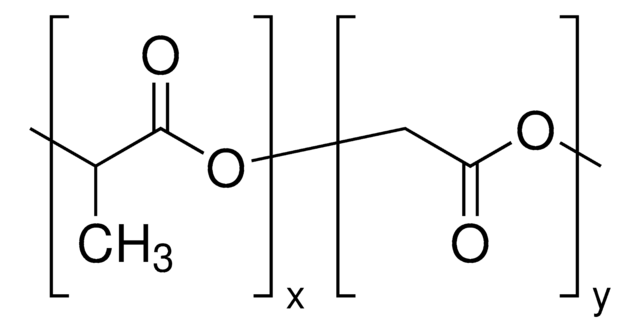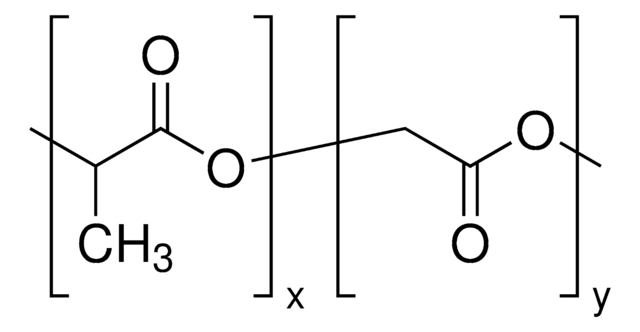P2191
Poly(D,L-lactide-co-glycolide)
lactide:glycolide (50:50), mol wt 30,000-60,000
Synonym(s):
LACTEL® B6010-2, PLGA
Sign Into View Organizational & Contract Pricing
All Photos(3)
About This Item
Linear Formula:
[C3H4O2]x[C2H2O2]y
MDL number:
UNSPSC Code:
12352211
PubChem Substance ID:
NACRES:
NA.25
Recommended Products
feed ratio
lactide:glycolide (50:50)
mol wt
30,000-60,000
storage temp.
−20°C
SMILES string
OCC(O)=O.CC(O)C(O)=O
Looking for similar products? Visit Product Comparison Guide
General description
Poly(D,L-lactide-co-glycolide) is a biodegradable and biocompatible polymer, which is used for drug delivery. It is used to treat rheumatoid arthritis, ulcerative colitis, Crohn′s disease, inflammatory lung diseases and ophthalmic inflammatory disorders. Poly(D,L-lactide-co-glycolide) functions as a potential cancer therapeutic target.
Application
Poly(D,L-lactide-co-glycolide) has been used to raise and sustain an increased lactate monomer level in the gel at a concentration relevant to dermal wounds.
Features and Benefits
Controlled release of bioactive agents, sutures and bioabsorbable implantable devices.
Physical form
Biocompatible, biodegradable polymer.
Legal Information
Lactel is a registered trademark of Evonik Corp
Storage Class Code
11 - Combustible Solids
WGK
WGK 3
Flash Point(F)
Not applicable
Flash Point(C)
Not applicable
Personal Protective Equipment
dust mask type N95 (US), Eyeshields, Gloves
Certificates of Analysis (COA)
Search for Certificates of Analysis (COA) by entering the products Lot/Batch Number. Lot and Batch Numbers can be found on a product’s label following the words ‘Lot’ or ‘Batch’.
Already Own This Product?
Find documentation for the products that you have recently purchased in the Document Library.
Customers Also Viewed
Characterization of biodegradable poly (D, L-lactide-co-glycolide) polymers and microspheres
Hausberger AG and DeLuca PP
Journal of Pharmaceutical and Biomedical Analysis, 13(6), 747-760 (1995)
Aerobically derived lactate stimulates revascularization and tissue repair via redox mechanisms
Hunt TK, et al.
Antioxidants & Redox Signaling, 9(8), 1115-1124 (2007)
PLGA-based nanoparticles: an overview of biomedical applications
Danhier F, et al.
Journal of Controlled Release : Official Journal of the Controlled Release Society, 161(2), 505-522 (2012)
Habibun Nabi et al.
Parasitology research, 116(1), 359-370 (2016-10-28)
Toxoplasmosis is one of the most common zoonotic protozoal diseases. Recent advances in biotechnology have produced recombinant protein, which are immunogenic, and progress in nano-pharmaceutics has generated encapsulated protein in nanospheres, which are suitable for vaccine delivery. DNA was extracted
Ahmed A Abd-Rabou et al.
Biological trace element research, 193(2), 377-389 (2019-05-09)
Colon cancer in men and breast cancer in women are regarded as major health burdens, accounting for majority of cancer diagnoses globally. Doxorubicin (DOX) resistance in breast and colon cancers represents the main reason of unsuccessful therapy. The rationale of
Our team of scientists has experience in all areas of research including Life Science, Material Science, Chemical Synthesis, Chromatography, Analytical and many others.
Contact Technical Service








